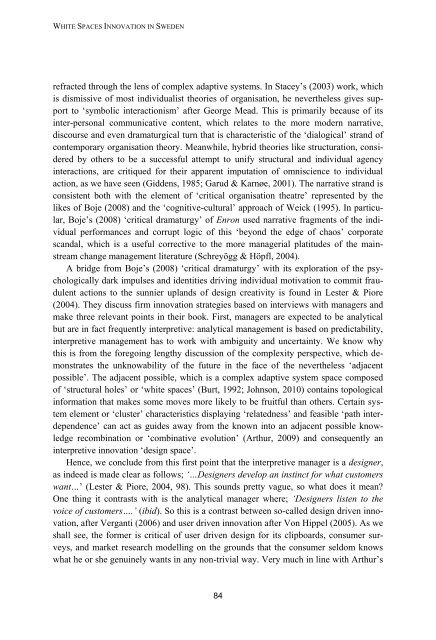White Spaces Innovation in Sweden - Innovation policy for ... - Vinnova
White Spaces Innovation in Sweden - Innovation policy for ... - Vinnova
White Spaces Innovation in Sweden - Innovation policy for ... - Vinnova
You also want an ePaper? Increase the reach of your titles
YUMPU automatically turns print PDFs into web optimized ePapers that Google loves.
WHITE SPACES INNOVATION IN SWEDENrefracted through the lens of complex adaptive systems. In Stacey‟s (2003) work, whichis dismissive of most <strong>in</strong>dividualist theories of organisation, he nevertheless gives supportto „symbolic <strong>in</strong>teractionism‟ after George Mead. This is primarily because of its<strong>in</strong>ter-personal communicative content, which relates to the more modern narrative,discourse and even dramaturgical turn that is characteristic of the „dialogical‟ strand ofcontemporary organisation theory. Meanwhile, hybrid theories like structuration, consideredby others to be a successful attempt to unify structural and <strong>in</strong>dividual agency<strong>in</strong>teractions, are critiqued <strong>for</strong> their apparent imputation of omniscience to <strong>in</strong>dividualaction, as we have seen (Giddens, 1985; Garud & Karnøe, 2001). The narrative strand isconsistent both with the element of „critical organisation theatre‟ represented by thelikes of Boje (2008) and the „cognitive-cultural‟ approach of Weick (1995). In particular,Boje‟s (2008) „critical dramaturgy‟ of Enron used narrative fragments of the <strong>in</strong>dividualper<strong>for</strong>mances and corrupt logic of this „beyond the edge of chaos‟ corporatescandal, which is a useful corrective to the more managerial platitudes of the ma<strong>in</strong>streamchange management literature (Schreyögg & Höpfl, 2004).A bridge from Boje‟s (2008) „critical dramaturgy‟ with its exploration of the psychologicallydark impulses and identities driv<strong>in</strong>g <strong>in</strong>dividual motivation to commit fraudulentactions to the sunnier uplands of design creativity is found <strong>in</strong> Lester & Piore(2004). They discuss firm <strong>in</strong>novation strategies based on <strong>in</strong>terviews with managers andmake three relevant po<strong>in</strong>ts <strong>in</strong> their book. First, managers are expected to be analyticalbut are <strong>in</strong> fact frequently <strong>in</strong>terpretive: analytical management is based on predictability,<strong>in</strong>terpretive management has to work with ambiguity and uncerta<strong>in</strong>ty. We know whythis is from the <strong>for</strong>ego<strong>in</strong>g lengthy discussion of the complexity perspective, which demonstratesthe unknowability of the future <strong>in</strong> the face of the nevertheless „adjacentpossible‟. The adjacent possible, which is a complex adaptive system space composedof „structural holes‟ or „white spaces‟ (Burt, 1992; Johnson, 2010) conta<strong>in</strong>s topological<strong>in</strong><strong>for</strong>mation that makes some moves more likely to be fruitful than others. Certa<strong>in</strong> systemelement or „cluster‟ characteristics display<strong>in</strong>g „relatedness‟ and feasible „path <strong>in</strong>terdependence‟can act as guides away from the known <strong>in</strong>to an adjacent possible knowledgerecomb<strong>in</strong>ation or „comb<strong>in</strong>ative evolution‟ (Arthur, 2009) and consequently an<strong>in</strong>terpretive <strong>in</strong>novation „design space‟.Hence, we conclude from this first po<strong>in</strong>t that the <strong>in</strong>terpretive manager is a designer,as <strong>in</strong>deed is made clear as follows; „…Designers develop an <strong>in</strong>st<strong>in</strong>ct <strong>for</strong> what customerswant…‟ (Lester & Piore, 2004, 98). This sounds pretty vague, so what does it mean?One th<strong>in</strong>g it contrasts with is the analytical manager where; „Designers listen to thevoice of customers….‟ (ibid). So this is a contrast between so-called design driven <strong>in</strong>novation,after Verganti (2006) and user driven <strong>in</strong>novation after Von Hippel (2005). As weshall see, the <strong>for</strong>mer is critical of user driven design <strong>for</strong> its clipboards, consumer surveys,and market research modell<strong>in</strong>g on the grounds that the consumer seldom knowswhat he or she genu<strong>in</strong>ely wants <strong>in</strong> any non-trivial way. Very much <strong>in</strong> l<strong>in</strong>e with Arthur‟s84
















